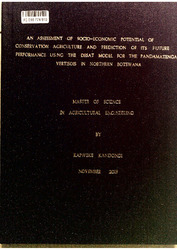| dc.description.abstract | This study was based in the Chobe District in Pandamatenga village in the northern region of Botswana. The main aim of the study was to assess the socio - economic potential of Conservation Agriculture (CA) technologies and to predict their future performance on sorghum grain yield using the Decision Support System for Agrotechnology Transfer (DSSAT) in the vertisols of Pandamatenga. A field experiment was conducted at the Department of Agricultural Research station at Pandamatenga during the 2015-2017 planting seasons. A randomized complete block design was used for the on-station field experimentation. The design had trial plots with four treatments, namely No tillage (NT), No tillage + mulch (NT+M), Minimum tillage (MT), and broad bed and furrow (BBF), with four replicates rotated between sorghum and cowpea. Sorghum grain yield results were analysed using the Statistical Analysis Software (SAS version 9.2). Analysis of variance and means were separated using Duncan’s multiple range test at 5% confidence level. The DSSAT model was also evaluated using the experimental data and weather data for the growing period. The model was further used to predict the performance of these CA technologies in terms of sorghum grain yield in the future.
A structured questionnaire was used for the collection of the socio - economic and demographic characteristics of the sampled smallholder rainfed farmers. Fanners’ perception and level of acceptance of CA technologies were also assessed in the study area. The socio - economic characteristics of the smallholder rainfed farmers included land holding size (hn), labour availability, livestock possession, education level, and farming experience. Demographic characteristics considered in this study were smallholder rainfed farmers’ age, marital status, gender and average number of family members in the household. Descriptive statistics (means, percentages) from Statistical Package for the Social Sciences (SPSS) Version 22 (IBM Corp, 2013) were used for data analysis of socio - economic and demographic characteristics of smallholder rainfed farmers. The binary logistic regression model was also used to analyse the farmers probability of adopting CA practice given a set of the socio- economic variables.
The results have shown that age, gender and farm size had a significant influence on smallholder rainfed farmers’ decision to adopt CA technologies in Pandamatenga region. Smallholder rainfed farmers had a positive perception and a high level of acceptance of CA technologies that were tried in their region. On average no tillage (594kg/ha) and no tillage plus mulch (560kg/ha) technologies were found to have the highest sorghum grain yield in different growing seasons in both continuous
and cowpea- rotated- with- sorghum trials. The DSSAT crop model provided reasonable predictions of sorghum grain yield under NT, MT, NT+M and BBF on vertisols of Pandamatenga. Even though the sorghum grain yields will be decreased in the mid - century (2040-2070), however the model further predicted that sustained NT+M practice by smallholder rainfed farmers in Pandamatenga would increase sorghum grain yield production in the future as compared to other CA technologies which were evaluated. Research, extension and planning agencies need to be sensitive to the age, gender and farm size of smallholder rainfed fanners when developing and disseminating agricultural technologies and strategies in the Pandamatenga area. No tillage mixed with mulch would be a suitable farming system for smallholder rainfed farmers for increased growth and enhancement of physical properties of vertisols. Thus, it is recommended that agricultural programmes should focus on the demonstration of no tillage mixed with soil surface cover to smallholder rainfed farmers in Pandamatenga. Modelling should be integrated in planning to assist smallholder rainfed farmers improve crop production to enhance food security sustainably. | en_US |

